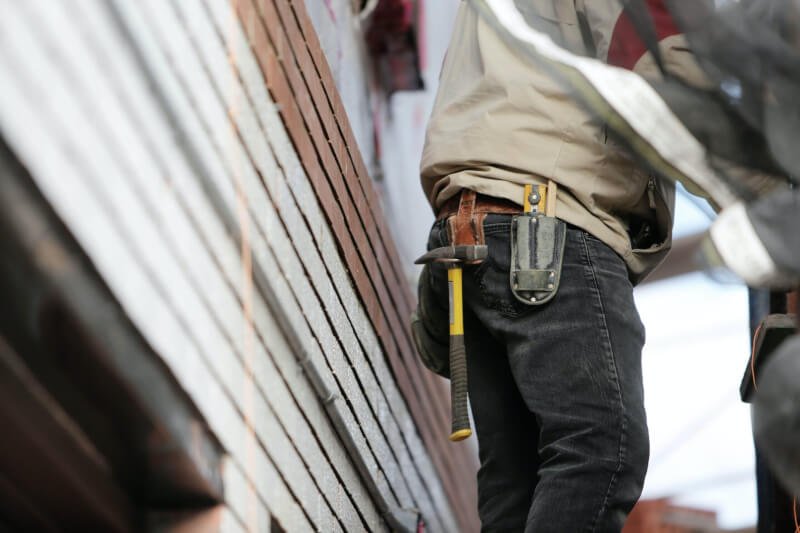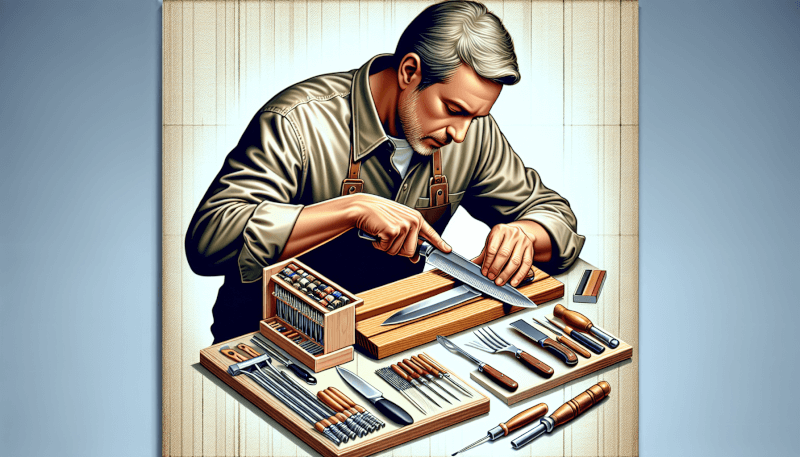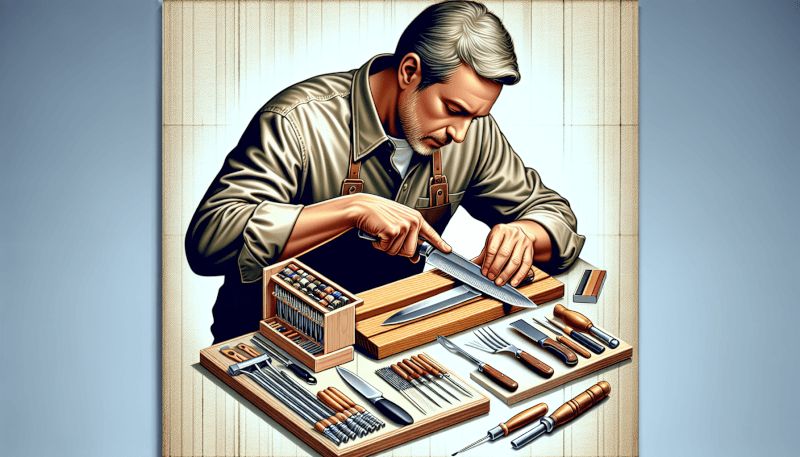Maintaining the sharpness of your serrated knives is essential for effortless slicing through bread, tomatoes, and other tough-skinned foods. But fear not, keeping those jagged edges razor-sharp is simpler than you might think. From proper storage to regular honing, this article will provide you with practical tips and tricks to ensure your serrated knives are always ready for action. So, let’s dive in and discover the secrets to maintaining the sharpness of your serrated knives!

Understanding Serrated Knives
What are serrated knives?
Serrated knives are kitchen knives with a unique, tooth-like edge pattern. Unlike traditional smooth-edged knives, they have a series of small, pointed teeth along the cutting edge. These teeth are designed to grip and tear through tough surfaces, making serrated knives especially useful for cutting bread, tomatoes, and other delicate items with tough, slippery skins.
Why are serrations important?
The serrations in knives serve a specific purpose. They increase the cutting efficiency and effectiveness by reducing the amount of force required to cut through certain foods. The tooth-like serrations create small points of contact, making it easier to penetrate the surface and maintain a stable cutting motion. Without serrations, smooth-edged knives may slide or crush certain foods, leading to uneven cuts and potential accidents.
Common types of serrated knives
Serrated knives come in various shapes and sizes, each suited for specific tasks. Some common types of serrated knives include bread knives, tomato knives, utility knives, and steak knives. Bread knives, with their long, narrow serrated blades, are perfect for slicing through crusty bread without crushing the soft interior. Tomato knives are designed with a narrow, serrated blade that allows for precise cutting of tomatoes without squishing or tearing. Utility knives are versatile and can handle a wide range of cutting tasks, while steak knives combine serrated edges with a sturdy blade for effortless slicing through meat.
Importance of Proper Care
Why is it important to maintain the sharpness of serrated knives?
Maintaining the sharpness of serrated knives is crucial for several reasons. First and foremost, a sharp knife is safer to use. When a knife is dull, more pressure is required, increasing the risk of slips and accidents. Additionally, a sharp knife ensures clean and precise cuts. A dull serrated knife can crush delicate foods instead of making clean slices, resulting in unappetizing presentations and potential loss of flavor and texture.
Benefits of a sharp serrated knife
A sharp serrated knife offers numerous benefits in the kitchen. It effortlessly slices through even the toughest textures, such as crusty bread or tough-skinned fruits, without damaging or squishing the delicate interiors. By maintaining a sharp edge, you will also experience less hand fatigue, as the knife glides through the food without requiring excessive force. A sharp serrated knife, when used correctly, can truly enhance your culinary experience.

Recommended Maintenance Tools
Choosing the right sharpening tools
To maintain the sharpness of your serrated knives, it is essential to invest in the right sharpening tools. Traditional sharpening stones or diamond files are not suitable for serrated knives, as they can damage the delicate teeth. Instead, opt for specially designed sharpeners that match the curve and shape of the serrated edge.
Understanding the different types of sharpeners
There are two main types of sharpeners for serrated knives: honing rods and tapered sharpeners. Honing rods are long, cylindrical rods with a fine grit that can be inserted into each serration, straightening and smoothing the teeth. Tapered sharpeners, on the other hand, have conical or cylindrical stones that are designed to match the serration size and shape. They allow for both sharpening and honing the serrated edge.
Alternatives to specialized sharpening tools
If you don’t have access to specialized sharpening tools, there are a few alternatives you can try. One option is to use a ceramic mug with an unglazed bottom. Simply run the serrated edge along the unglazed surface, applying light pressure. Another alternative is a handheld sharpening tool with a conical or cylindrical design that can fit into the serrations, allowing you to sharpen and hone the teeth.
Proper Cleaning and Storage
Cleaning serrated knives
To maintain the sharpness and longevity of your serrated knives, it is vital to clean them after each use. Start by rinsing the blade under warm water to remove any food debris. Then, use a mild dish soap and a soft sponge or cloth to gently scrub the blade. Be careful not to apply excessive force or use abrasive materials that can damage the serrations. Once cleaned, rinse the knife thoroughly to remove any soap residue.
Drying and storing serrated knives
After cleaning, it is crucial to dry your serrated knives completely to prevent the risk of rusting and corrosion. Use a clean, soft towel to carefully dry the blade, paying special attention to the serrated edge. Avoid air-drying the knife, as moisture can linger and cause damage. Once dry, store your serrated knives in a knife block or sheath to protect the blade and prevent accidental cuts.

Regular Sharpening Techniques
When should serrated knives be sharpened?
Serrated knives do not require sharpening as frequently as their smooth-edged counterparts. However, they still benefit from regular maintenance to ensure optimal performance. As a general rule of thumb, sharpen your serrated knives every six to twelve months, depending on usage. Signs that your knife might need sharpening include noticeable dullness, difficulty in cutting, and increased pressure required to make clean cuts.
Safety precautions for sharpening serrated knives
When sharpening serrated knives, it is essential to take the necessary safety precautions to avoid accidents. Always wear a cut-resistant glove on the hand holding the knife, ensuring your fingers are protected from potential slips or slips. Additionally, work in a well-lit area on a stable surface to maintain control over the knife and sharpening tool.
Step-by-step guide for sharpening serrated knives
To sharpen your serrated knife, follow these steps:
Select an appropriate tool: Choose a sharpening tool specifically designed for serrated knives, such as a honing rod or tapered sharpener.
Identify the correct angle: Position the sharpening tool at the angle that matches the serrations on your knife. This will ensure a proper sharpening and honing process.
Insert the tool into each serration: Gently insert the tool into each serration and move it back and forth, following the natural curve of the serrated edge. Apply light pressure and repeat for all serrations.
Hone the serrated edge: After sharpening, use the honing rod or tapered sharpener to smooth and align the teeth. Run the tool lightly along the entire serrated edge, maintaining a consistent angle.
Test the sharpness: Carefully run your finger along the blade to test the sharpness. Be cautious and avoid applying excessive pressure. A properly sharpened serrated knife should feel sharp and glide smoothly.
Honing Serrated Knives
The role of honing in maintaining the sharpness
Honing plays a crucial role in maintaining the sharpness of serrated knives. While sharpening actually removes material from the blade to create a new edge, honing is the process of straightening and refreshing the existing edge. By running a honing rod or tapered sharpener along the serrations, you can realign the teeth, ensuring they remain sharp and effective.
How to hone serrated knives effectively
To effectively hone your serrated knife, follow these steps:
Select a honing rod or tapered sharpener: Choose the tool that matches the size and shape of your serrated knife’s teeth.
Hold the knife securely: Grip the handle firmly and position the serrated edge against the honing rod or sharpener.
Start honing: Apply light pressure and gently push the rod or sharpener into the serrations. Move it back and forth along the full length of the blade, ensuring each tooth comes into contact with the tool.
Repeat the process: Depending on the condition and sharpness of your knife, repeat the honing process a few times until the serrated edge feels smooth and the teeth are realigned.

Maintaining the Teeth of Serrated Knives
Tips for preventing damage to serrated knife teeth
To prevent damage to the teeth of your serrated knife, remember the following tips:
Avoid cutting on hard surfaces, such as ceramic or glass cutting boards, as they can cause premature wear and tear on the teeth. Opt for softer materials like wood or plastic cutting boards instead.
Use a gentle slicing motion when cutting to minimize the stress on the teeth. Avoid applying excessive force or using a sawing motion, as both can accelerate wear and potentially chip the teeth.
Store your serrated knives separately from other utensils, preferably in a knife block or sheath, to avoid contact that can lead to dulling or bending of the teeth.
Dealing with broken or damaged teeth
If you encounter broken or damaged teeth on your serrated knife, it is best to consult a professional knife maintenance service. Attempting to repair or replace the teeth yourself can be challenging and may result in further damage to the knife. A professional can assess the damage and provide the necessary repairs, ensuring your knife retains its intended functionality.
Professional Maintenance Services
When to seek professional maintenance for serrated knives
There are certain situations when seeking professional maintenance for your serrated knives is recommended. If you notice significant dullness, excessive chipping, or any structural issues with the knife, it is best to seek assistance from a professional. They have the expertise and tools required to address complex issues and restore your knife to its optimal condition.
Choosing a reliable knife maintenance service
When selecting a knife maintenance service, consider the following factors:
Reputation: Look for reviews and recommendations from trusted sources to ensure the service has a good reputation for quality work.
Experience: Choose a service that has years of experience in knife maintenance, specifically serrated knives.
Specialization: Verify that the service specializes in serrated knives, as they require specific techniques and tools for proper maintenance.
Cost and turnaround time: Inquire about the cost and turnaround time for maintenance services. Compare different options to find the best balance of affordability and efficiency.

Common Mistakes to Avoid
Mistakes that can damage the sharpness of serrated knives
To maintain the sharpness of your serrated knives, avoid the following common mistakes:
Using a traditional sharpener: Traditional sharpening stones or diamond files are not suitable for serrated knives. They can damage the teeth or create an uneven cutting edge, rendering the knife less effective.
Applying excessive force: Serrated knives are designed to do the work efficiently, so avoid exerting excessive force. Applying too much pressure while cutting can damage the teeth and potentially cause accidents.
Neglecting regular maintenance: Regular maintenance, including honing and sharpening, is essential for serrated knives. Neglecting these steps can lead to dullness, reduced performance, and potential damage.
How to avoid common pitfalls
To avoid the common pitfalls mentioned above, follow these tips:
Invest in specialized sharpening tools designed for serrated knives. They will provide the best results without risking damage to the teeth.
Practice proper cutting techniques, using a gentle slicing motion instead of excessive force or a sawing motion.
Make regular maintenance a part of your routine. Set reminders or establish a schedule to ensure you don’t neglect the care of your serrated knives.
Additional Tips and Tricks
Tips for extending the sharpness of serrated knives
To extend the sharpness of your serrated knives, consider these tips:
Use a cutting board made of wood or plastic to minimize wear on the teeth.
Avoid cutting frozen foods with serrated knives, as the extreme cold can damage the teeth.
Store your serrated knives in a knife block or sheath to protect the cutting edge from unnecessary contact.
Using serrated knives correctly
To get the most out of your serrated knives, follow these guidelines:
Use a gentle sawing motion when cutting through tough-skinned fruits or vegetables. This will allow the teeth to grip and penetrate the surface without undue pressure.
Hold the handle firmly and apply steady, even pressure to ensure a smooth cutting motion.
Allow the teeth to do the work, avoiding the temptation to exert excessive force or pressure.
Testing the sharpness of serrated knives
To test the sharpness of your serrated knife, try the following:
Lightly run your finger along the blade’s edge, moving from the handle to the tip. Be cautious and avoid applying too much pressure.
A properly sharpened serrated knife should feel sharp and glide smoothly along your finger, with no snagging or resistance.
In conclusion, understanding and properly maintaining serrated knives is essential for optimal performance in the kitchen. By following the recommended maintenance practices, using the appropriate sharpening tools, and avoiding common mistakes, you can ensure your serrated knives stay sharp, efficient, and safe to use for years to come. So, take the time to care for your serrated knives, and they will reward you with precise, effortless cuts every time.


